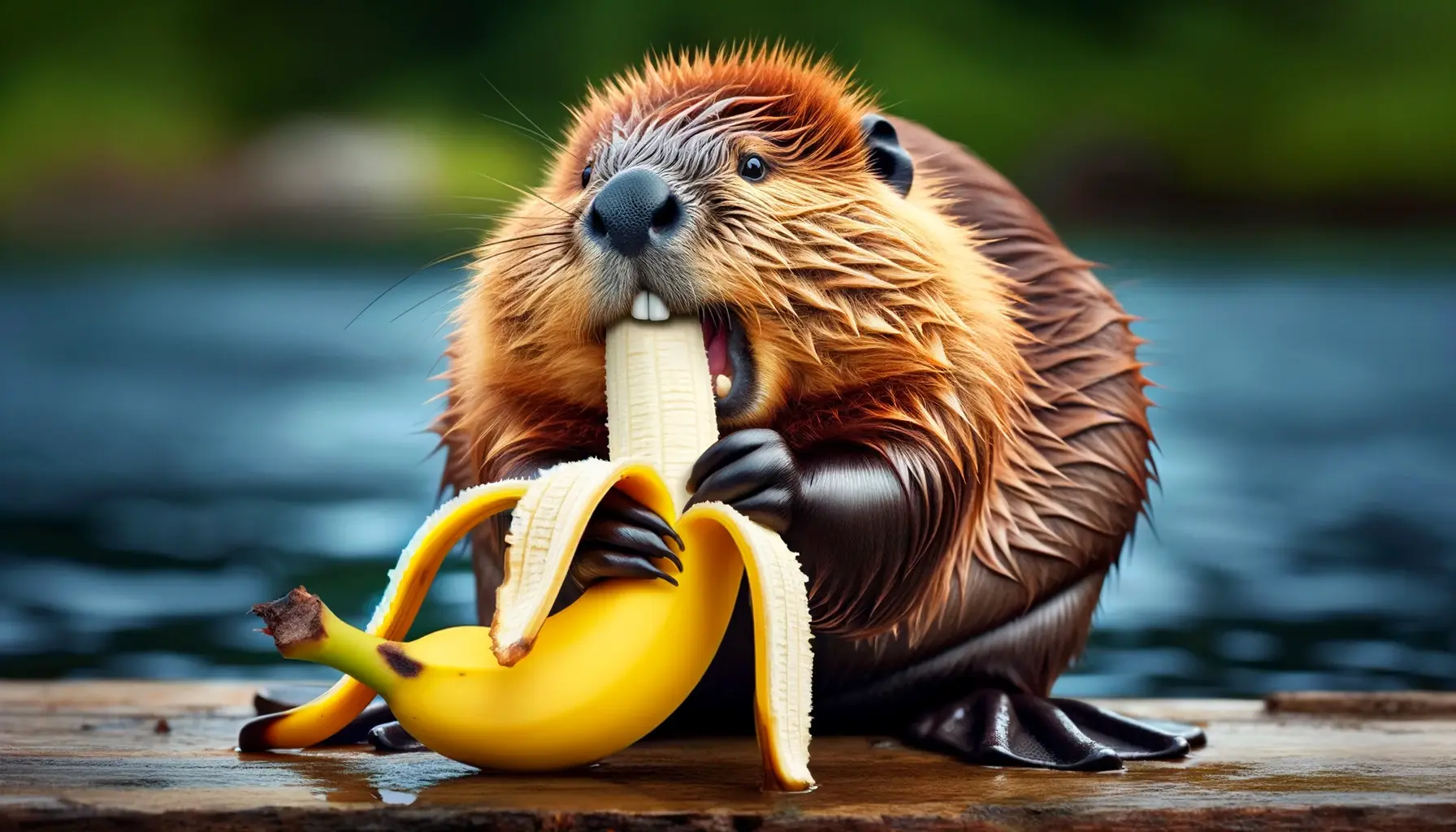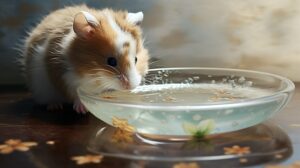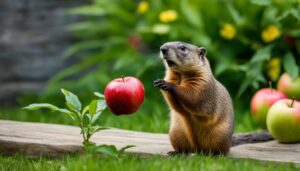Did you know that beavers have a unique diet that primarily consists of bark, twigs, leaves, and aquatic plants?
These industrious creatures are nature’s architects, reshaping landscapes and building elaborate dams. But have you ever wondered if beavers can eat bananas, a fruit commonly consumed by humans?
Yes, while beavers primarily consume bark, twigs, and leaves, they can potentially eat bananas as well, although it’s important to consider their unique dietary preferences and nutritional needs when introducing new foods into their diet. Bananas are not part of their natural diet and should only be offered in moderation.
In this article, we will explore the natural diet of beavers and delve into the possibility of feeding them bananas. We’ll also debunk common myths about their diets and provide guidelines for feeding beavers in captivity.
Key Takeaways:
- Beavers have a unique diet consisting of bark, twigs, leaves, and aquatic plants.
- While beavers primarily consume these plant materials, there is curiosity about whether they can eat bananas.
- Feeding beavers in captivity requires following specific guidelines to ensure their health and well-being.
- There are common myths surrounding beavers’ diets that we will debunk.
- Understanding the nutritional needs of beavers is crucial when introducing new foods into their diet.
Understanding Beavers’ Natural Diet
Beavers have a fascinating and unique natural diet that consists of a variety of plant materials. Let’s delve into what these industrious creatures typically eat and explore their nutritional needs.
What Do Beavers Typically Eat?
Beavers are herbivores, meaning they rely solely on plant-based foods for sustenance. Their diet primarily consists of bark, twigs, leaves, and aquatic plants.
One of their favorite food sources is the inner bark of trees, especially the soft cambium layer. They also consume small branches, twigs, and leaves from a wide range of tree species.
Nutritional Needs of Beavers
Beavers have specific nutritional requirements that they fulfill through their natural diet. The plant materials they consume provide them with essential nutrients, including carbohydrates, fiber, minerals, and vitamins.
These nutrients are necessary for their overall health and well-being.
Understanding the beavers’ natural diet is crucial in determining the best care and feeding practices for these incredible animals.
By providing them with the proper nutrition, we can help ensure their vitality and contribute to their long-term survival.
Can Beavers Eat Bananas?

While beavers primarily eat bark, twigs, and leaves, there is a possibility that they can consume bananas.
Bananas are a soft and easily digestible fruit, which may make them suitable for beavers to eat.
The Possibility of Feeding Bananas to Beavers
Beavers’ diets mainly consist of plant materials such as bark, twigs, and leaves. However, given the soft texture of bananas, there is a possibility that beavers can include this tropical fruit in their diet.
Bananas can provide additional nutritional benefits due to their rich content of vitamins and minerals.
How Beavers Might React to Bananas
While bananas are considered safe for human consumption, it is important to consider how beavers might react to this unfamiliar fruit.
Beavers have specific dietary preferences and may not be accustomed to the taste and texture of bananas.
Introducing bananas into their diet can have varying reactions, and it is essential to monitor their response.
The Impact of Fruits on Beavers’ Health

Feeding fruits to beavers can have both positive and negative impacts on their health. Fruits are a rich source of essential vitamins and minerals that can contribute to the overall well-being of these aquatic mammals.
However, it is important to consider the quantity and type of fruit being fed to beavers, as excessive consumption can lead to digestive issues and other health problems.
When it comes to feeding fruits to beavers, it is crucial to strike a balance. Including a variety of fruits in their diet can provide them with additional nutrients and a more diversified palate.
However, feeding fruits should be done in moderation, considering that beavers’ natural diet consists mainly of bark, twigs, and leaves.
Pros and Cons of Feeding Fruits to Beavers
- Provides essential vitamins and minerals
- Offers a variety of flavors and textures
- Can enhance the overall nutritional profile of their diet
- Excessive consumption can lead to digestive issues
- May disrupt their natural feeding behaviors
- Can contribute to an imbalanced diet if not properly regulated
Suitable Fruits for Beavers
Not all fruits are suitable for beavers, as some may be too acidic, contain harmful substances, or have a texture that does not align with their natural eating habits.
Here are some fruits that can be included in a beaver’s diet:
- Apples
- Pears
- Berries (strawberries, blueberries, raspberries)
- Watermelon (seedless)
- Oranges (in moderation)
It is important to introduce fruits gradually into a beaver’s diet and closely monitor their response. If any negative effects or changes in behavior are observed, it is advisable to consult with a veterinarian or a wildlife expert.
Feeding Beavers: Best Practices and Considerations

When it comes to feeding beavers, there are important best practices and considerations to keep in mind to ensure the well-being of these fascinating creatures.
Whether you are caring for beavers in captivity or come across wild beavers, understanding the guidelines for their diet and addressing the risks associated with feeding them is crucial.
Guidelines for Feeding Beavers in Captivity
Feeding beavers in captivity requires careful consideration to mimic their natural diet as closely as possible.
Here are some guidelines to follow:
- Provide a variety of tree species: Beavers rely on the inner bark, small branches, twigs, and leaves of different tree species for their nutritional needs. Offer a diverse selection of trees that are commonly found in their native habitats.
. - Ensure access to fresh water: Beavers are semiaquatic animals, so access to clean and fresh water is essential. Provide a water source that allows them to engage in their natural behaviors, such as swimming and building dams.
. - Monitor food intake: Beavers have specific dietary requirements, and it’s important not to overfeed or underfeed them. Monitor their food intake and adjust the quantities accordingly to maintain their health.
. - Consult with experts: If you are unsure about the specific dietary needs of beavers or need guidance on their feeding habits, consult with experts such as wildlife rehabilitators, veterinarians, or zoologists.
The Risks of Feeding Wild Beavers
While it may be tempting to feed wild beavers, it is generally discouraged due to the following risks:
- Dependency on human foods: Feeding wild beavers can lead to dependence on human-provided foods, which may disrupt their natural foraging behaviors and impact their ability to find suitable food sources in the wild.
. - Loss of natural behaviors: Regular food handouts can discourage beavers from engaging in their natural behaviors, such as building dams and foraging. This can have detrimental effects on their overall well-being and the ecosystems they inhabit.
. - Health concerns: Feeding beavers inappropriate or unbalanced diets can lead to health issues, including digestive problems and nutrient deficiencies. Wild beavers have evolved to thrive on their natural diets, and introducing unfamiliar foods may disrupt their health.
. - Human-wildlife conflicts: Feeding wild beavers can increase their proximity to human habitations, leading to potential conflicts and negative interactions. It is best to admire these fascinating creatures from a distance without interfering with their natural diet and behaviors.
By adhering to the best practices for feeding beavers in captivity and understanding the risks involved in feeding wild beavers, we can contribute to their well-being and conservation.
Let’s continue to appreciate and protect these remarkable animals while ensuring they receive the proper nourishment they need.
Common Myths About Beavers’ Diets

Beavers’ diets have long been the subject of myths and misconceptions. In this section, we aim to debunk these misunderstandings and provide factual information about what beavers actually eat.
By dispelling these myths, we hope to provide a clearer understanding of the nutritional needs and dietary habits of these fascinating creatures.
Debunking Misconceptions
1. Myth: Beavers only eat wood.
Fact: While beavers are known for their ability to fell trees and construct dams, their diet is not limited to wood. In fact, the majority of a beaver’s diet consists of bark, twigs, leaves, and aquatic plants. These plant materials provide the necessary nutrients for their survival.
2. Myth: Beavers can survive solely on aquatic plants.
Fact: While beavers do consume a significant amount of aquatic plants, they require a diverse diet to meet their nutritional needs. Aquatic plants alone do not provide sufficient carbohydrates, fiber, minerals, and vitamins necessary for their overall health and well-being.
3. Myth: Beavers eat fish and small animals.
Fact: Beavers are herbivores and do not eat fish or small animals as part of their natural diet. They rely solely on plant materials for sustenance. Their unique anatomy, including their large incisors, is specifically adapted for cutting through tree bark and twigs, not for capturing or consuming meat.
Fact: While beavers may consume a variety of plant materials, their diet should not consist of processed or unhealthy foods like junk food. Providing such foods can lead to nutritional imbalances and health issues in beavers, just as it would in any other animal.
5. Myth: Beavers eat bananas.
Fact: There is some speculation about whether beavers can eat bananas, but their natural diet does not include tropical fruits. While beavers have been known to explore new food sources in captivity, it is important to prioritize their natural diet to ensure their nutritional needs are met.
By debunking these misconceptions, we can promote a better understanding of beavers’ dietary requirements and contribute to their overall well-being.
Conclusion
In conclusion, beavers have a natural diet that consists of bark, twigs, and leaves, but they may also be able to consume other food items such as bananas.
However, it is crucial to consider their unique dietary preferences and nutritional needs when introducing new foods into their diet.
Beavers in captivity should be fed according to specific guidelines to ensure their health and well-being, while it is generally recommended to avoid feeding wild beavers.
By debunking common myths about beavers’ diets, we can gain a clearer understanding of these fascinating creatures and their nutritional requirements.
It is important to recognize that their primary source of sustenance is derived from the materials they find in their natural habitat.
While beavers may have the ability to eat bananas or other fruits, it is essential to provide them with a balanced diet that meets their specific nutritional needs.
Feeding beavers in captivity should be done responsibly, taking into account their natural feeding behaviors and the potential consequences of introducing unfamiliar foods.
By following established guidelines, we can ensure that beavers receive the nutrition they require while minimizing any negative impacts on their health.
For those with a fascination for these remarkable creatures, understanding their diets and debunking misconceptions allows us to appreciate the vital role they play in their ecosystems.
Frequently Asked Questions
Q: Do beavers eat fruit?
A: Beavers are primarily herbivores that eat bark and cambium, the soft tissue that grows under the bark of trees. While fruit is not a major part of their diet, they may occasionally eat fruits available in their environment.
Q: What can I feed a beaver?
A: If you need to feed a beaver, suitable foods include fresh tree branches (aspen and willow are favorites), aquatic plants, and leaves. Avoid feeding beavers human food.
Q: Will beavers eat corn?
A: Beavers might eat corn if it is available, but it is not a natural part of their diet. They primarily feed on tree bark and aquatic vegetation.
Q: What trees do beavers not eat?
A: Beavers prefer certain trees like aspen, cottonwood, willow, and alder. They tend to avoid trees with very hard wood or those with high resin content, such as pine and spruce.
Q: What is beaver favorite food?
A: Beavers’ favorite food includes the bark of aspen, willow, maple, birch, cottonwood, and alder trees. They also enjoy aquatic plants.
Q: What do beavers not eat?
A: Beavers do not eat meat or fish as they are strict herbivores. They also tend to avoid trees with hard wood or high resin content, like pine and spruce.
Q: Will beavers eat peanut butter?
A: While beavers might be curious about peanut butter due to its smell, it is not a natural or healthy food for them and should not be offered.
Q: Can beavers have carrots?
A: Beavers can technically eat carrots, as they are herbivores, but their natural preference is for aquatic vegetation and the bark of certain trees rather than garden vegetables.




